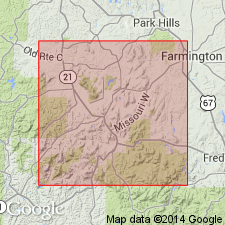
- Usage in publication:
-
- Butler Hill granite
- Modifications:
-
- First used
- Dominant lithology:
-
- [Granite]
- AAPG geologic province:
-
- Midcontinent region
Summary:
Butler Hill granite (new) of Bevos group (new). Briefly summarized in reports by F.G. Snyder and R.E. Wagner, p. 14, 15, 16, 17, and W.C. Hayes, p. 81, 83 (table 1), this volume. New names are credited to Tolman and Robertson (in prep.) [1969, Missouri Div. Geol. Survey Water Res. Rpt. Inv., no. 44 (Contrib. to Precambrian Geol., no. 1)]. Borders Skrainka diabase on north. In contact with Stouts Creek rhyolite on west slope of Knoblick Mountain. Age is Precambrian.
Occurs in St. Francois Mountain area. Butler Hill is in T. 34 N., R. 6 E., St. Francois Co., southeastern MO.
Source: Modified from US geologic names lexicon (USGS Bull. 1350, p. 106).
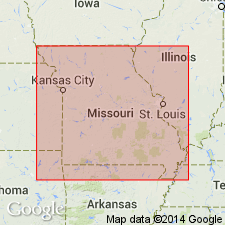
- Usage in publication:
-
- Butler Hill Granite
- Modifications:
-
- Geochronologic dating
- AAPG geologic province:
-
- Midcontinent region
Summary:
Isotopic evidence [method not specified] suggest that Butler Hill and Silvermine granites are 1400-1450 m.y. old. Study area is in St. Francois Mountains, southeast MO, Midcontinent region.
Source: GNU records (USGS DDS-6; Denver GNULEX).

- Usage in publication:
-
- Butler Hill granite
- Modifications:
-
- Principal reference
- Dominant lithology:
-
- Granite
- AAPG geologic province:
-
- Midcontinent region
Summary:
Pg. 42. Butler Hill granite of Bevos group. A medium- to coarsely medium-grained, light-red to pink granite. Weathers to very large boulders; jointing produces vertical columns as high as 80 feet. Exposed in St. Francois Mountains, southeastern Missouri, notably near town of Syenite. Formed during later phase (of 2) of batholithic intrusion. Appears to have differentiated in place. Represents a differentiated stage between Breadtray and Silvermine granites, both of Bevos group; Breadtray was last of batholithic rocks of St. Francois Mountains to differentiate. Age is Precambrian.
Named from exposures on Butler Hill, in sec. 7, T. 34 N., R. 6 E., St. Francois Co., MO. (Type locality not designated.)
See C.E. Robertson, 1995, Precambrian rocks, IN T.L. Thompson, Stratigraphic succession in Missouri (revised-1995), Missouri Division of Geology and Land Survey, 2nd series, v. 40 Revised, p. 5-14.
Source: Strat. succession in Missouri (Thompson, 1995, p. 12); GNU records (USGS DDS-6; Denver GNULEX).
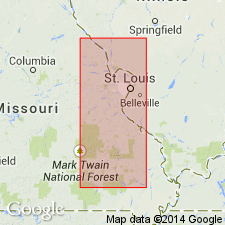
- Usage in publication:
-
- Butler Hill Granite
- Modifications:
-
- Geochronologic dating
- AAPG geologic province:
-
- Midcontinent region
Summary:
U-Pb age of 1495 +/-20 m.y. determined on zircon; Rb-Sr age separates. Rb-Sr ages on some rocks are consistently lower than U-PB ages probably due to removal of Sr from rock. Samples are taken from St. Francois Mountains, southeast MO, Midcontinent region.
Source: GNU records (USGS DDS-6; Denver GNULEX).
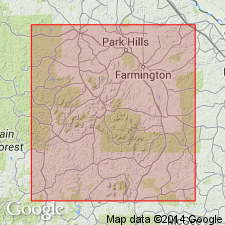
- Usage in publication:
-
- Butler Hill Granite
- Modifications:
-
- Geochronologic dating
- AAPG geologic province:
-
- Midcontinent region
Summary:
U-Pb age on zircons determined to be 1500 +/-20 m.y. and Rb-Sr data on whole-rock samples and on one sample of potassium feldspar yields ages of 1408 +/-72 m.y. and 1350 +/-50 m.y. respectively. It is believed that U-Pb age is most reliable. Rb-Sr data probably underestimates actual age; low age probably due to Sr loss. Samples taken in T34N, R6E, St. Francois Co, MO, Midcontinent region (specific localities listed in appendix 3). Analytical data in appendices 2 and 4.
Source: GNU records (USGS DDS-6; Denver GNULEX).
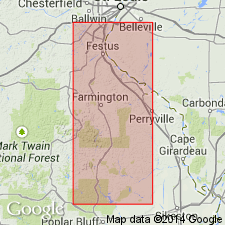
- Usage in publication:
-
- Butler Hill Granite
- Modifications:
-
- Geochronologic dating
- AAPG geologic province:
-
- Midcontinent region
Summary:
Whole rock Rb-Sr age of 1408 +/-72 m.y. and zircon U-Pb age of 1500 +/-20 m.y. on Butler Hill in St. Francois Mountains, MO, Midcontinent region. U-Pb age is probably more reliable than Rb-Sr age because of less analytical scatter and more consistent results for U-Pb data and probable lowering of Rb-Sr age due to loss of Sr.
Source: GNU records (USGS DDS-6; Denver GNULEX).
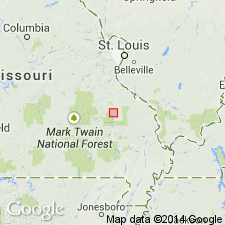
- Usage in publication:
-
- Butler Hill Granite
- Modifications:
-
- Revised
- Areal extent
- Overview
- AAPG geologic province:
-
- Midcontinent region
Summary:
Unit is largest single intrusive body (180 sq km of surface exposure) in St. Francois Mountains batholith, southeast MO, Midcontinent region. Tolman and Robertson (1969) thought that Butler Hill pluton was made up of two separate granites: Butler Hill and Breadtray Granites. Breadtray (abandoned) now thought to be fine-grained facies of Butler Hill Granite and is referred to as Breadtray facies of Butler Hill Granite. Granite is chemically homogeneous though grades from medium-grained plagioclase-bearing granite in northeast to fine-grained, plagioclase-poor granite (Breadtray facies) in southwest. Fine grained facies crystallized rapidly just beneath volcanic roof; coarser grained facies cooled more slowly and at greater depth. Chemical analyses. St. Francois batholith is 52 km wide; 35 km are volcanic rocks and 17 km is Butler Hill. Butler Hill was emplaced into volcanic roof during and shortly after formation of roof with crystallization in upper crust occurring at depth of not more than 10 km. Precambrian age.
Source: GNU records (USGS DDS-6; Denver GNULEX).
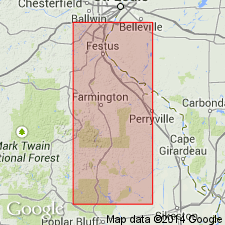
- Usage in publication:
-
- Butler Hill Group
- Modifications:
-
- Revised
- AAPG geologic province:
-
- Midcontinent region
Summary:
Butler Hill Granite (referred to in table 1 as "Butler Hill-Breadtray Granites"), one of seven Precambrian Y plutonic rock units assigned to the /St. Francois Mountains Intrusive Suite (revised). [Previously assigned to Bevos Group by Tolman and Robertson (1969); status of Bevos not discussed.] Present in St. Francois Mountains, southeast Missouri (Midcontinent region). Oldest plutonic rocks in the area; older than "Slabtown-Stono Granites" (revised) of St. Francois Mountains. Age is Precambrian Y. Nomenclature listed in table 1.
[Conflicts with nomenclature guidelines (ACSN, 1970; NACSN, 1983, 2005, 2021): name Butler Hill applied concurrently to two different units in same area; name St. Francois Mountains applied concurrently to two different units in same area.]
Source: Modified from GNU records (USGS DDS-6; Denver GNULEX).
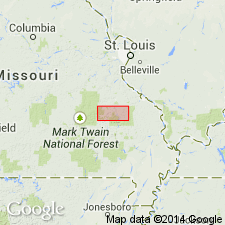
- Usage in publication:
-
- Butler Hill granite
- Modifications:
-
- Revised
- Overview
- AAPG geologic province:
-
- Midcontinent region
Summary:
Butler Hill granite. Includes rocks previously assigned to the Brown Mountain rhyolite porphyry [not used]; Brown Mountain has similar mineralogy as Breadtray facies of Butler Hill and is considered part of Butler Hill. Mapped in central St. Francois Mountains, southeastern Missouri (Midcontinent region). Outcrops in approximate circular pattern in area of Iron Mountain, Doe Run, and Knob Lick. Intrudes Grassy Mountain ignimbrite and Lake Killarney formation on west, south, and east; nonconformably underlies lower Paleozoic rocks, most commonly Upper Cambrian Lamotte sandstone, on north and northeast. Low-silica plutons (Silvermine, Stono, Knoblick, and Slabtown granites) occur around margin of larger, high-silica Butler Hill; contacts are not well enough exposed to determine intrusive relationships except that Brown Mountain [Breadtray facies] is intruded by Silvermine granite. Everywhere that contacts are observed, plutonic rocks are younger than, and intrude volcanic rocks of St. Francois Mountains. Age is Proterozoic.
[Authors' intentions are unclear as to which, if any, of the geologic units discussed should have formal status.]
Source: GNU records (USGS DDS-6; Denver GNULEX).
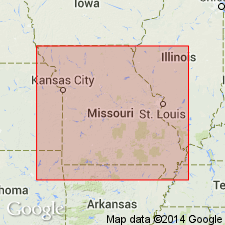
- Usage in publication:
-
- Butler Hill Granite
- Modifications:
-
- Revised
- Overview
- AAPG geologic province:
-
- Midcontinent region
Summary:
Revised in that Butler Hill underlies Wolf Mountain Ignimbrite (first used) in central St. Francois Mountains, southeast MO, Midcontinent region. Mapped (fig. 1) east of regional angular unconformity. (Rocks east and north of unconformity are older than rocks west of it). Chemically similar to Grassy Mountain Ignimbrite. Petrologic data. Younger than Stono Granite which Butler Hill intrudes. Proterozoic age (1440-1480 Ma).
Source: GNU records (USGS DDS-6; Denver GNULEX).
For more information, please contact Nancy Stamm, Geologic Names Committee Secretary.
Asterisk (*) indicates published by U.S. Geological Survey authors.
"No current usage" (†) implies that a name has been abandoned or has fallen into disuse. Former usage and, if known, replacement name given in parentheses ( ).
Slash (/) indicates name conflicts with nomenclatural guidelines (CSN, 1933; ACSN, 1961, 1970; NACSN, 1983, 2005, 2021). May be explained within brackets ([ ]).

